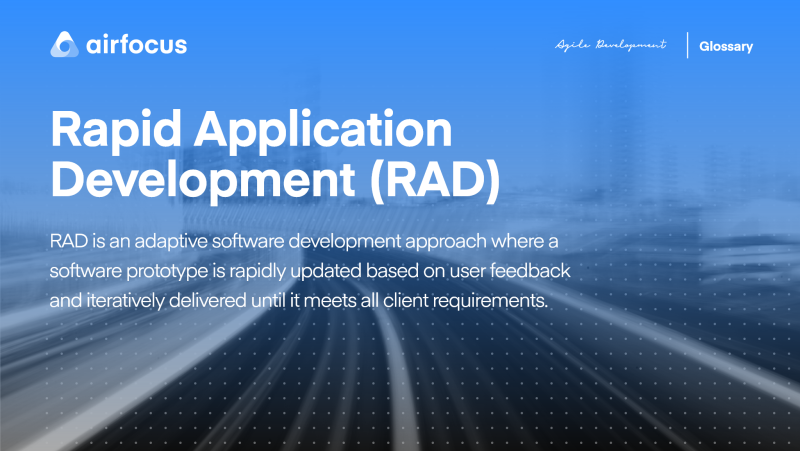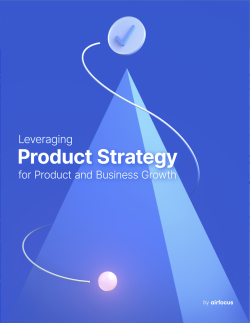Rapid Application Development (RAD)
What is Rapid Application Development
Definition of Rapid Application Development (RAD)
Rapid Application Development (RAD) is an adaptive software development approach where a software prototype is rapidly updated based on user feedback and iteratively delivered until it meets all client requirements.
In the Rapid Application Development model, the software development team and the client (this may be an internal client) work together to define the scope of the project. The client communicates their project goals, expectations, and issues that need to be addressed by the software. The development team evaluates the requirements and finalizes an agreed set of features to be delivered.
Once the requirements are finalized, developers design modularized prototypes that can be repeatedly refined to incorporate customer feedback and change requirements until it meets all client expectations.
During the Rapid Application Development process, development happens rapidly because most of the blockers and issues are usually identified at the design phase and eliminated in advance.
The continuous client engagement with the development team increases customer satisfaction. Hence RAD is known to be a software development model that reduces the risk associated with the software development process and ensures the delivery of high-quality software during a short time.
What is RAD in agile?
Rapid Application Development (RAD) is a style of agile development that aims to provide high-quality outcomes quickly.
Contrary to the Waterfall methodology, RAD emphasizes procedures over design. RAD repurposes existing code, models, and tried-and-true procedures to build new software prototypes.
As a result, web applications and software developers may benefit from the Rapid Application Development model's flexibility, adaptability, and time-saving features. The RAD method works well in situations when you need to create new apps within a short time frame.
On the other hand, agile delivery methods address the requirement for more agile client delivery in the IT sector, which helps modernize businesses. The goal is to create dynamic and adaptable projects with a significant shift in managers' and internal team members' cultures and perspectives.
RAD creates processes that are focused on speed and flexibility and combines them with the flexible approach of the agile methodology.
Agile uses a lot of intelligent software to help the development process. In agile, professionals and tools work together with active team engagement to create successful but streamlined products. Customers may receive the bare minimum of features before the project's completion, and they may even receive them in stages or parts.
But what’s the difference between Rapid Application Development and Agile methodology?
In contrast to Agile's emphasis on production time, rapid application development promotes quick prototyping instead of more expensive planning.
While Agile and RAD emphasize the first delivery of software and continue to adapt to new needs even in later stages of development, Agile takes things a step further by outlining its specific processes, working conditions, and principles.
In this way, the RAD technique can be more flexible, stressing the quality of outcomes without imposing any significant rules.
The “Agile methodology” refers to a distinct project management approach with set rules and processes. Although Agile development takes a bit longer, it aims to help teams create great products by giving them a set structure and pre-defined tools.
RAD is a better option when you are working on a project with a short timeframe. This is because RAD is focused on immediate actions and outcomes — perfect for those tight turnarounds.
Agile is different because it places a greater emphasis on the individuals doing the job and how they collaborate. The goal is for multidisciplinary teams to work together to develop solutions while adhering to the best practices for each environment.
Phases of RAD
Rapid Application Development framework consists of four main phases.
Requirements planning: The software development team and the client define the scope of the project and finalize the requirements.
User Design: Developers design the prototype and continuously refine it to incorporate client feedback until it meets expectations.
Rapid Construction: The software developers rapidly build the designed prototype into a functional software, iteratively updating it to incorporate feedback.
Cutover: The prototype is finalized, and goes into production. Changes and improvements can still be introduced iteratively following the RAD model.
The history of Rapid Application Development
The RAD model was introduced as an alternative solution to the traditional waterfall software development life cycle (SDLC) model.
The initial solution was developed by Barry Boehm, and was known as the "spiral model". Taking inspiration from Barry's work, the RAD model was formally introduced to the software industry by James Martin through his book "Rapid Application Development" which was published in 1991 while he was working for IBM.
Limitations of the RAD Model
While the Rapid Application Development model can be a highly effective agile framework, it does have some limitations.
For example, the RAD model is not recommended when customer goals and requirements are unclear, and when the design cannot be broken in a modular way.
In the RAD model, it is important to clearly and precisely identify requirements before designing the prototype.
This requires team members with excellent domain knowledge, which may not always be available, particularly in smaller businesses that may be reliant on external experts.
Advantages of Rapid Application Development
Rapid iteration: Rapid Application Development empowers developers to develop quickly and iteratively, by prototyping advanced software in a modular way. Ultimately, this means that users can get a functioning product in less time.
Reusability: This approach reduces rework by encouraging the reusability of development components.
Minimizes risk: RAD prevents software from failing entirely as the functionality of the software prototype is reviewed and tested during earlier delivery cycles.
Fewer integration issues: This approach has fewer integration issues because integration takes place from the very beginning, and the new features and improvements can be introduced to the prototype on the go.
Disadvantages of Rapid Application Development
Requires modularity: One of the main drawbacks of this model is that it can only be applied to software systems that can be modularized into small components. Typically this means that the RAD model only works with small to medium-sized projects. It tends to run into issues with bigger, more complex setups.
Requires a high skill level across the team: The success of a Rapid Application Development prototype relies on the ability of designers and developers to deliver precise work at pace. This means that RAD might not be the best model for teams without the level of expertise needed to do this.
Demands continuous user involvement: The nature of the RAD model demands ongoing user feedback in order to be able to iteratively improve on prototypes. Many businesses may not be able to secure user engagement throughout each stage of the project, meaning that iterations are subject to internal bias.

General FAQ

Glossary categories
Create effective product strategy

Experience the new way of doing product management








